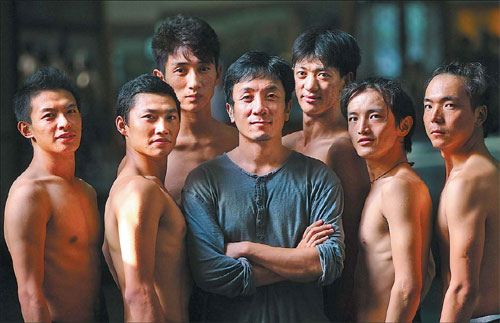Essential elements
Updated: 2012-08-10 09:31
By Chen Nan (China Daily)
|
|||||||||||
 |
|
Tibetan dancer-choreographer Wanma Jiancuo (middle) with dancers for his new work Shambhala. Photos by Zou Hong / China Daily |
Tibetan dancer-choreographer Wanma Jiancuo says his new work Shambhala depicts the spiritual pursuit of tranquility, balance and happiness. Chen Nan reports in Beijing.
Tibetan folk dances and songs are widely performed at national galas as they are thought to be mysterious and charming, attracting millions of tourists to explore the country's Tibetan areas. However, Tibetan dancer-choreographer Wanma Jiancuo says it's not the real Tibet that is being portrayed.
"Those superficial decorations cover the essence of Tibetan culture."
He has also choreographed a 60-minute dance, Shambhala, which means pure land and blissful heaven, in the Tibetan language, depicting the spiritual pursuit of tranquility, balance and happiness. He calls it a "private work", expressing his emotions for Tibetan culture.
"For many people, Shambhala, or Shangri-La, is a popular tourism site. But for Tibetans, it's a spiritual resting place, not something tangible or concrete," he says.
"When I was a kid, my parents told me that you should be a virtuous man and then you will find your Shangri-La," Wanma Jiancuo recalls. "Everyone has his own Shangri-La in their heart."
The dance will be performed at the National Center for the Performing Arts on Aug 15 and 16, as part of Chinese Dance Masterpieces, a month-long event featuring six dance shows by Chinese dancers and choreographers.
On a scorching afternoon, Wanma Jiancuo and eight Tibetan dancers gather in a dance rehearsal room at Minzu University of China. Sitting around an incense burner, they relax.
"I need them to be focused, serious and show respect to the dance," says Wanma Jiancuo. "It's a rite of passage."
As one male dancer rings a bronze Tibetan hand bell and walks slowly, the others follow him with their eyes staring forward. They pick up some objects and worship them sincerely, such as a horse saddle, wooden box, and the beam of a house, which were collected by Wanma Jiancuo from Tibetan families.
Most of the time, there is no music but deep, slow Tibetan chanting. The only sounds are the dancers' feet stepping on the floor and their heavy breaths. Their costumes are simple and gray.
"The clothes at galas are not worn daily by Tibetans. We only wear formal dress during festivals," 22-year-old dancer Tsering Norbu says.
The big-eyed curly-haired young man has studied dancing since childhood and now works at Song and Dance Troupe of Tibet Autonomous Region. He is a big fan of Wanma Jiancuo and volunteered to perform.
"Like the costumes, the dance overturns Tibetan dance impressions. It's real and powerful. Usually I dance on national occasions and assigned missions to celebrate some event. I have to smile happily and dance like it's a festival. But this is anything but conventional," says the dancer, who arrived in Beijing a month ago from Lhasa.
Related Stories
Where there are Chinese there are always lion dance costumes 2012-08-08 14:24
Time to harvest in Tibet 2012-08-07 15:45
People of Tibetan ethnic group enjoy outing on outskirts of Lhasa 2012-08-07 13:34
Forum on Tibetan studies opens in Beijing 2012-08-03 10:05
Centuries-old Tibetan calligraphy kept alive 2012-08-02 10:38
Today's Top News
Rescuers race against time for quake victims
Telecom workers restore links
Coal mine blast kills 18 in Jilin
Intl scholarship puts China on the map
More bird flu patients discharged
Gold loses sheen, but still a safe bet
US 'turns blind eye to human rights'
Telecom workers restore links
Hot Topics
Lunar probe , China growth forecasts, Emission rules get tougher, China seen through 'colored lens', International board,
Editor's Picks

|

|

|

|

|

|









